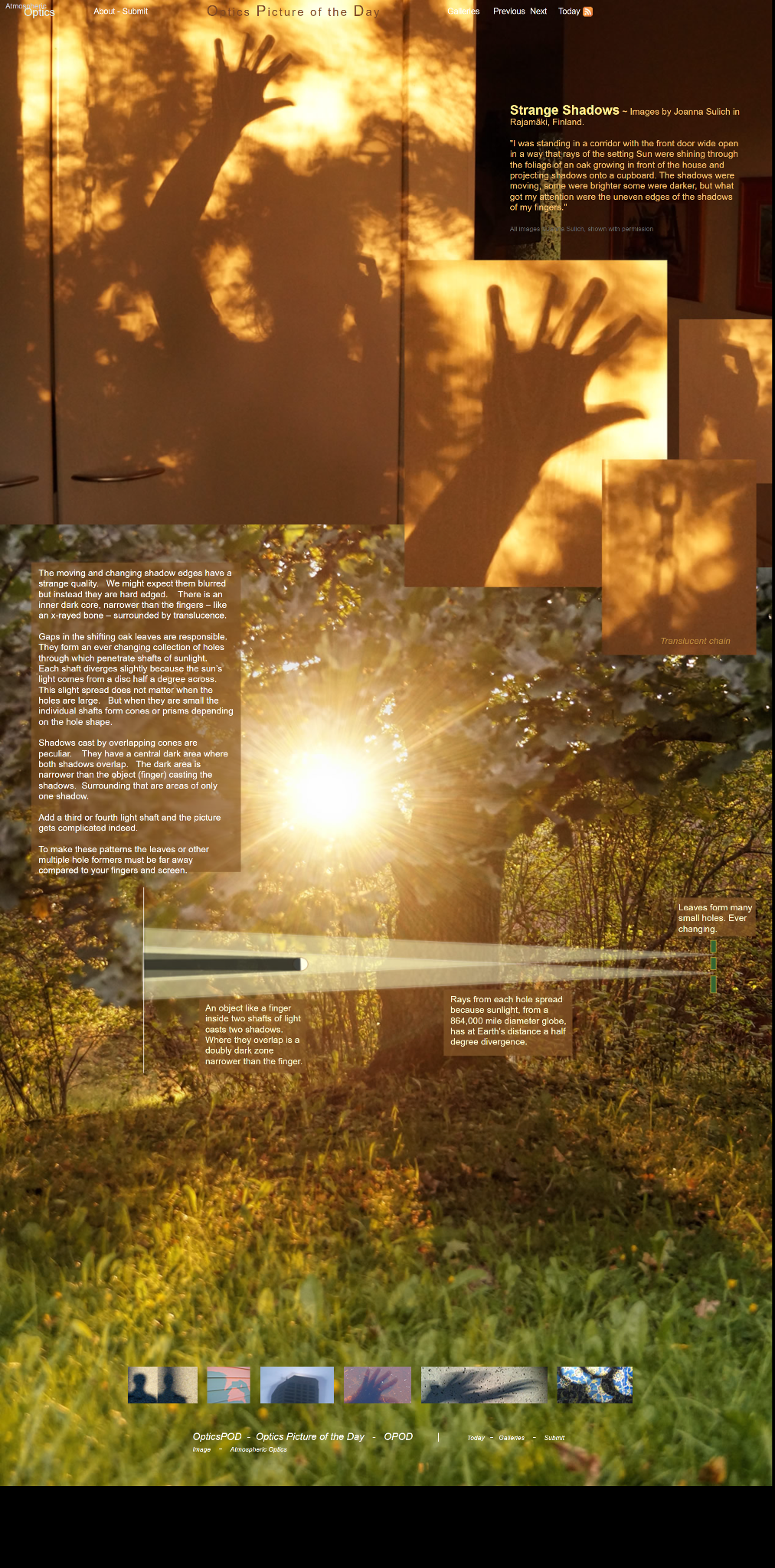Strange Shadows - OPOD
Strange Shadows - Exploring the Peculiarities of Shadow Edges
Have you ever noticed the peculiar qualities of shadows? Sometimes, they seem to have hard edges instead of the expected blurriness. These mysterious shadows can captivate our attention and leave us pondering their origins. One such observer, Joanna Sulich from Rajamäki, Finland, experienced this phenomenon firsthand.
As Sulich stood in a corridor with the front door wide open, she noticed something peculiar. The rays of the setting Sun were shining through the foliage of an oak tree in front of her house, casting intriguing shadows onto a nearby cupboard. What caught her eye were the uneven edges of the shadows formed by her fingers. They seemed to possess an otherworldly quality that defied our conventional expectations.
Upon closer examination, Sulich discovered that these shadow edges were not only hard but also possessed an inner dark core, resembling an x-rayed bone. This inner core was narrower than the fingers, surrounded by a translucent border. The question arises: What causes these strange shadow phenomena?
The answer lies in the gaps present in the shifting oak leaves. These gaps act as a collection of ever-changing holes through which sunlight penetrates. However, due to the small size of these holes, the individual shafts of sunlight diverge slightly, forming cones or prisms depending on the shape of the hole. It is within these overlapping cones or prisms that the peculiar shadows are cast.
When multiple cones or prisms overlap, the resulting shadows exhibit unique characteristics. A central dark area is formed where the shadows overlap, which is narrower than the object casting the shadows (in this case, Sulich's fingers). Surrounding this doubly dark zone are areas where only one shadow is present. The interplay between these overlapping shadows creates intricate patterns that mesmerize observers.
To further complicate matters, introducing a third or fourth light shaft into the mix adds another layer of complexity to the picture. The interplay between the various light shafts and their corresponding shadows creates a visual spectacle that challenges our perception of light and shadow.
It is important to note that these shadow phenomena occur when the leaves or other multiple hole formers are located at a considerable distance from the object casting the shadows. This distance allows for the formation of many small holes, which constantly change as the leaves sway in the breeze.
In the case of Sulich's observation, the sunlight, originating from a 864,000 mile diameter globe we call the Sun, diverges due to its source's immense size. At Earth's distance, this divergence amounts to half a degree. As a result, each individual hole in the shifting oak leaves allows sunlight to spread and form cones or prisms, leading to the creation of these mesmerizing shadow patterns.
In conclusion, the peculiar shadows observed by Joanna Sulich in Rajamäki, Finland, are a captivating display of the interplay between light, objects, and the ever-changing gaps in shifting oak leaves. These shadow phenomena defy our expectations, exhibiting hard edges and an inner dark core that adds to their enigmatic allure. By understanding the mechanisms behind these strange shadows, we gain a deeper appreciation for the wonders of atmospheric optics and the intricate nature of light and shadow.
Strange Shadows ~ Images by Joanna Sulich in Rajamäki, Finland.
"I was standing in a corridor with the front door wide open in a way that rays of the setting Sun were shining through the foliage of an oak growing in front of the house and projecting shadows onto a cupboard. The shadows were moving, some were brighter some were darker, but what got my attention were the uneven edges of the shadows of my fingers."
All images ©Janna Sulich, shown with permission
The moving and changing shadow edges have a strange quality. We might expect them blurred but instead they are hard edged. There is an inner dark core, narrower than the fingers – like an x-rayed bone – surrounded by translucence.
Gaps in the shifting oak leaves are responsible. They form an ever changing collection of holes through which penetrate shafts of sunlight. Each shaft diverges slightly because the sun’s light comes from a disc half a degree across. This slight spread does not matter when the holes are large. But when they are small the individual shafts form cones or prisms depending on the hole shape.
Shadows cast by overlapping cones are peculiar. They have a central dark area where both shadows overlap. The dark area is narrower than the object (finger) casting the shadows. Surrounding that are areas of only one shadow.
Add a third or fourth light shaft and the picture gets complicated indeed.
To make these patterns the leaves or other multiple hole formers must be far away compared to your fingers and screen.
Leaves form many small holes. Ever changing.
An object like a finger inside two shafts of light casts two shadows. Where they overlap is a doubly dark zone narrower than the finger.
Rays from each hole spread because sunlight, from a 864,000 mile diameter globe, has at Earth's distance a half degree divergence.

Note: this article has been automatically converted from the old site and may not appear as intended. You can find the original article here.
Reference Atmospheric Optics
If you use any of the definitions, information, or data presented on Atmospheric Optics, please copy the link or reference below to properly credit us as the reference source. Thank you!
-
<a href="https://atoptics.co.uk/blog/strange-shadows-opod/">Strange Shadows - OPOD</a>
-
"Strange Shadows - OPOD". Atmospheric Optics. Accessed on April 19, 2024. https://atoptics.co.uk/blog/strange-shadows-opod/.
-
"Strange Shadows - OPOD". Atmospheric Optics, https://atoptics.co.uk/blog/strange-shadows-opod/. Accessed 19 April, 2024
-
Strange Shadows - OPOD. Atmospheric Optics. Retrieved from https://atoptics.co.uk/blog/strange-shadows-opod/.